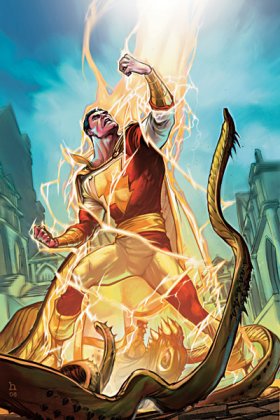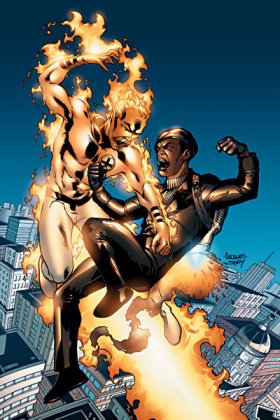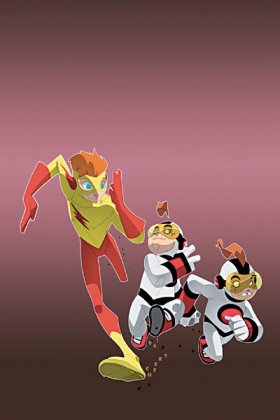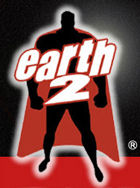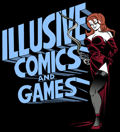|
The
Fanboy Planet Preview Spotlight 08/30/06
brought to you by FanboyPlanet.Comics
of Santa Clara
(ask for Steve, and he'll give you the worst
oatmeal cookie you've ever tasted...)
Each
week we look through the upcoming releases to offer our two
cents as to what's hot and what's not. You can agree with
us or not, but spend your money wisely. The
Trials of Shazam #1
writer: Judd Winick
artist: Howard Porter
To get into
this book, you have to throw away two preconceived notions:
what you think Captain Marvel should be like, and what you
think Howard Porter's art looks like. The Trials of Shazam
may change your opinion.
The original
Captain Marvel (as DC used to bill him) has a special place
in the hearts of almost every major creator you could ask.
Everybody has a favorite Captain Marvel story from the Golden
Age, or they just love that strange combination of power
of a god with the heart of a child. Yet nobody seems to
know a way to make the character stick with the masses in
any meaningful (read: financially successful) way today.
Jerry Ordway
came close in the nineties with The Power Of Shazam.
Certainly the rethinking he did of the concept still has
resonance today. Ordway's vision of Black Adam has a powerful
presence right now, most obviously in 52. As for
Captain Marvel himself, Ordway managed to find a balance
between Billy Batson's adolescent enthusiasm and the seriousness
of the threats the World's Mightiest Mortal must face.
However, if
we have to acknowledge some passage of time in a
character's continuity, the idea of a twelve year old boy
with that much power works for only so long. Everybody has
to grow up some time.
At least, that's
what Judd Winick seems to be saying with The Trials of
Shazam, and whether you agree or not with the premise,
he sets it up fairly. In the aftermath of the Crisis, with
"wild magic" roaming the Earth, Captain Marvel seems pretty
confident in his place in the scheme of things.
What he seems
to be ignoring is that wild magic might apply to the lightning,
too. His appearance here seems to be after the events of
the Brave New World one-shot, but Winick doesn't
mention the cliffhangers he left Mary and Junior in that
story. Instead, we get the groundwork for Junior to step
up, possibly because the whole family is about to get promoted
a rank.
And no, that
doesn't mean we're going to see the Lieutenant Marvels,
though Winick has said he will make it clear why not. On
a side note, though, it's okay to strip away some of those
more outright silly elements - though Fat Billy always gave
me hope. Just leave Tawky Tawny alone.
The Shazam mythos
isn't the only thing that changes with this book. Artist
Porter changes up his style, and it's for the better. Despite
his run on some acclaimed books, his art has always left
me cold. What he's doing here, though, has my interest.
His figure construction is still a bit angular, but the
stylization seems more purposeful, and he's either inking
himself or coloring directly on his pencils for a cool softer
tone effect.
It gives the
book the look of illustrations from children's adventure
story books from fifties. Somehow, it's like we're peeking
into somebody's view of modern mythology unfolding - appropriate,
as Winick is lifting his structure from the labors of Hercules.
With
Winick, you'll still get some whimsy. It's one of his strengths.
But it's clearly not intended to be one of the features;
this take is more serious.
I'm
keeping a cynical eye on this one, just because I think
there's still room for the innocence of Captain Marvel's
original personality and look forward to Jeff Smith's still
in the works Shazam! project. But with this first
issue, Winick and Porter have made me take notice, offer
respect, and want to see where they're going with this.
Also on the
Stands:
The American
Way #7: In troubled times, we claim we want a hero.
John Ridley and Georges Jeanty have gone to an earlier troubled
time and showing us the consequences of that wish. Some
of the plot turns have gone from surprising to sadly realistic,
and though some of the characters created here are clever
and well-drawn, it's clear that they exist for the context
of this story, and shouldn't go on. This is one neat self-contained
mini-series, and it's going to make one heck of a strong
trade paperback.
JLA Classified
#26: Howard Chaykin goes to the geopolitical well, trying
to make the late run of JLA be fish and fowl. Forbidden
to interfere in a conflict between two nations, the League
goes undercover and splits within itself when it's clear
that metahumans are being bred for conflict. At some points,
it almost reads like an early Authority story, but
Chaykin is too smart for that. His League remains the League,
and for a few pages, he even makes the "Waterbearer" Aquaman
a bit interesting. Ultimately, though, the scope is so big
this could leave readers cold.
Man-Bat #5:
Trying to reposition Man-Bat for the twenty-first century,
this mini-series just falls flat. Some of the most excessive
villains of the last few years get together to essentially
make Kirk Langstrom one of their own, and Bruce Jones thinks
he's moving the character forward. Instead, it's just a
slight variation on what we've seen before from back when
Man-Bat first appeared. The art feels klunky and lacks any
real frightening impact, and in the end, it's just a Batman
story in which Man-Bat is one of the menaces the Dark Knight
has to fight.
Solo #12:
Brendan McCarthy will make your head hurt, in a good way.
Throughout these pages, he twists superhero ideas on their
head, redefining The Flash and the Legion of Super-Heroes
in layer after layer of meta-fictional conceit. You'll have
to read it a few times; heck, you'll want to. Writing with
Tom O'Connor, McCarthy takes the JSA villain Johnny Sorrow
and reimagines it into a feature I want to see again. In
small doses, with aspirin and a cool cloth to put over my
forehead after I lie down to think about it.
Strange Girl
#10: Nick Stakal's art strikes me as interesting but
undisciplined, and that lack of discipline does not seem
to be part of the storytelling intent. What keeps me coming
back is Rick Remender, a writer that I hope never goes mainstream,
because he's too good at discussing important ideas here
in the gutters of genre fiction. There's some honest philosophical
debate going on among demons and rapture survivors, provoking
thought even while providing plenty of adventure.
Teen Titans
Go! #34: Not having watched the show, it's hard to say
if this fits in continuity. But it gets readers right into
the action, explains enough so nobody feels lost and moves
forward at a breakneck speed. Sure, fans of the animated
series might settle for it as cold comfort, but kids should
eat this up. Pay attention to these DC Kids books; they're
doing good work.
Uncle Sam
and the Freedom Fighters #2: The paranoid DC Universe
America here doesn't seem to jibe with any of the other
books right now. Getting that out of the way, though, Jimmy
Palmiotti and Justin Gray have started justifying the view
of the book, and if we could just return to multiple earths
and put the Freedom Fighters back on Earth X, this would
be awesome and not vaguely irritating. They've definitely
done more to develop Uncle Sam as a character with this
issue than anyone else has in a long time. Daniel Acuna's
really stands out, though sometimes Uncle Sam looks like
an anorexic Jack Black doing a Mr. Show sketch.
Sight Unseen:
All-Star
Superman #5: With all due respect to the creators slaving
away on the regular Superman books, this book kicks all
their butts. Grant Morrison writes a Superman so cool, it
makes me love Frank Quitely's art.
Doc Frankenstein
#5: This might be my favorite book, if I could remember
what happened last issue and why I liked it.
Snakes
On A Plane #1: Did anybody know DC was going to adapt
this? Will anyone care at this point?
Hey, write to us and
let us know what you think, or talk about it on the
forums!
|
